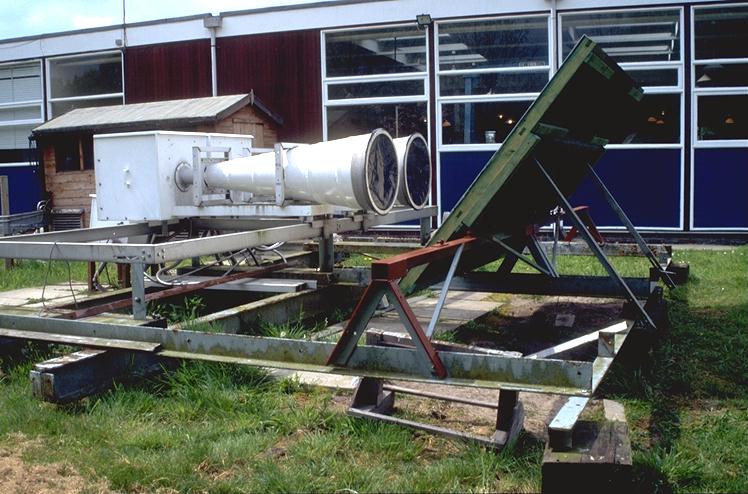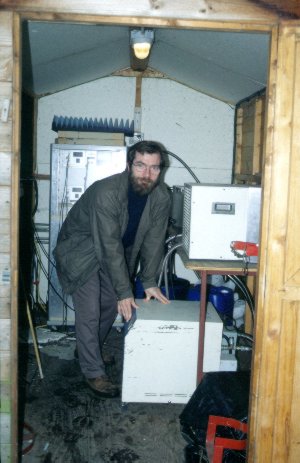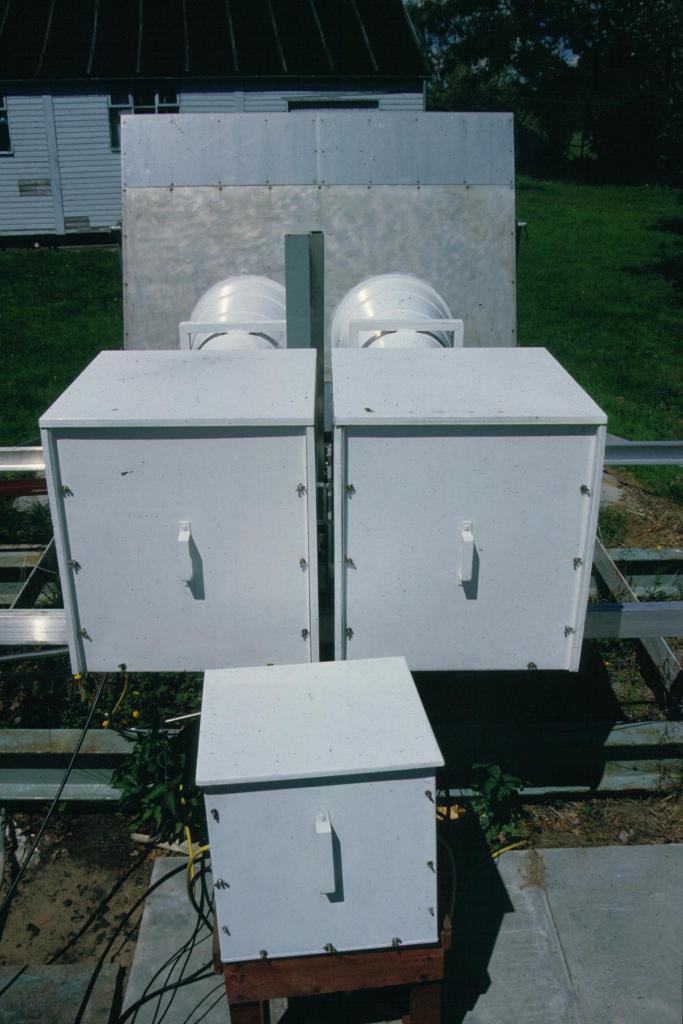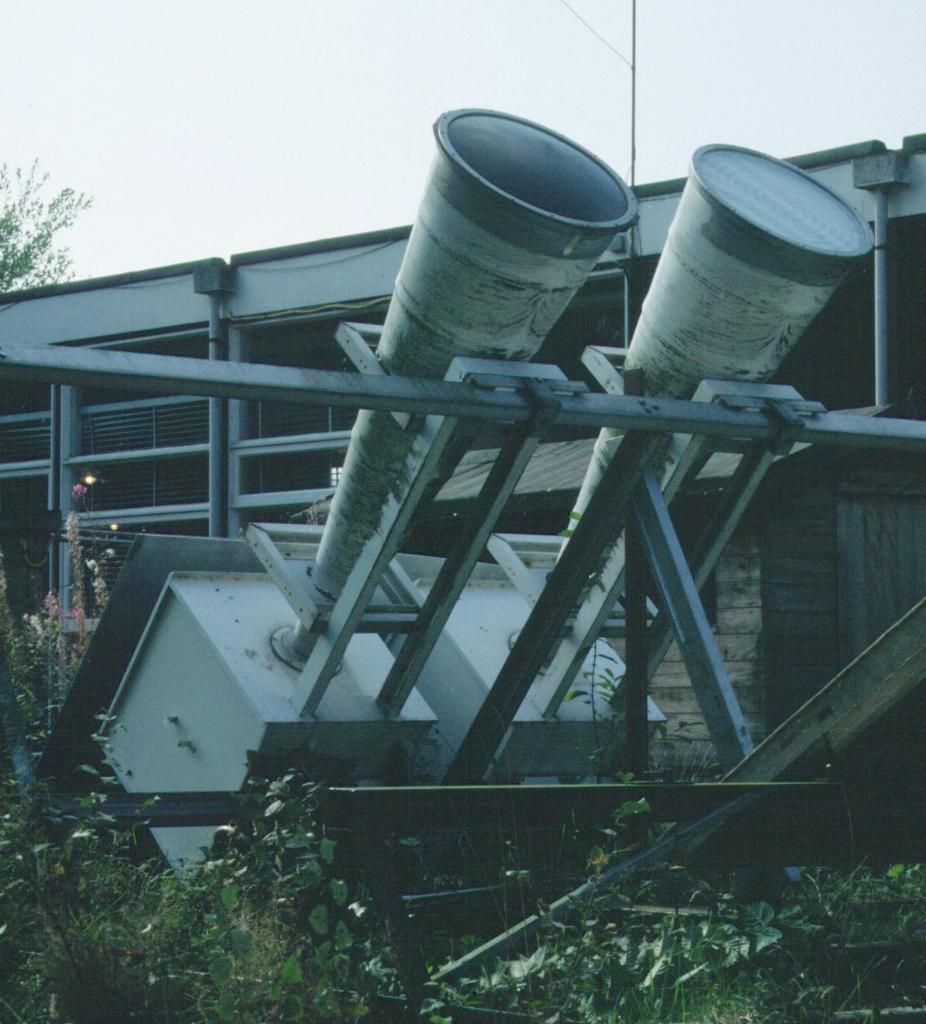5 GHz Interferometer
The 5 GHz CMB interferometer was switched off on 1st March 1999.

5 GHz Interferometer
| Location | Jodrell Bank, UK |
| Type | 2-element interferometer |
| Scanning | Earth rotation (drift) |
| Frequency | 5 GHz |
| Bandwidth | 400 MHz |
| Primary beam | 8° FWHM |
| l-range | 71 ± 13, 97 ± 13, 184 ± 13 |
This instrument, located at N.R.A.L., Jodrell Bank, 30 km south of Manchester, was a two-element interferometer, working at a frequency of 5 GHz. At this frequency we were able to operate in England, despite the poor weather. We also operate CMB telescopes at higher frequencies, and these have to be sited at a high altitude observatory on Tenerife, one of the Canary Islands, to reduce the atmospheric contamination to our data.

SJM switching off the compressor
for the 5 GHz receivers
The telescope had no tracking mechanism. Instead we let the Earth's rotation sweep the telescope beam across the sky, once each sidereal day. For most of its life the telescope received signals from the sky via a plain mirror (a large flat sheet of aluminium), which could be adjusted in elevation to point the telescope at different declinations. However, during 1998 and early 1999 we observed signals from around the north celestial pole, with the horns elevated to point directly at the sky.
Signals picked up by the receivers were taken to a complex correlator. This combined the signals by multiplying them together. The result is that when a source crossed the telescope beam the constructive and destructive interference of the two receiver signals in the correlator produced sine and cosine output fringes. These were recorded by a computer system and stored for later analysis. The operating principles are similar to those for the Young's double slit experiment or the Michelson Interferometer. The spacing of the two receivers was adjustable. Changing the spacing changed the angular response of the instrument. Moving the receivers further apart made the telescope more sensitive to finer structures in the sky (around a degree in extent) whilst moving them together improved the broad-scale response (a few degrees in extent).
Data from the interferometer are processed with SJM MIDAS.
Through the use of corrugated conical horns we had very low levels of pickup from antenna sidelobes. This means that we could safely use a very wide band-width (337 MHz) without being subject to interference. Such a wide band-width was made possible through the use of an analogue / analogue correlator.
The receivers were cooled to around 15 K by a closed-cycle helium expansion system. Helium gas was compressed to about 2000 kPa by a large compressor housed in the shed behind the telescope. The high pressure helium was then allowed to expand inside a heat exchanger built into each cryostat. The free expansion cools the cryostat contents via the heat exchanger, the low pressure helium then being returned to the compressor for re-use.
The very low noise temperature of our helium-cooled receivers (system noise temperature is around 19 K) combined with the 337-MHz band-width results in an extremely high sensitivity (around 0.3 mK per root second of integration). The telescope observed each declination strip for several weeks, giving an ultimate sensitivity, with all the data stacked together, of better than 0.05 mK per half degree RA bin.
Despite rigorous efforts to stabilize the temperature (monitoring data could be viewed as a table or on a graph) of critical parts of the system, there was some fluctuation in the amplitude and phase response of the telescope from day to day. This would make it impossible to integrate data over long time scales. For this reason we generated a reference signal that was injected into both receivers briefly every integration. By noting any amplitude or phase change in the reference signal we could compensate for the same changes on the astronomical signals.
The 5 GHz CMB Interferometer has been the subject of one PhD and three MSc theses by students working at Jodrell Bank. It has mapped Galactic and extragalactic emissions which may contaminate CMB measurements at low frequencies.
 |
 |
| 5 GHz narrow spacing | 5 GHz NCP configuration |


